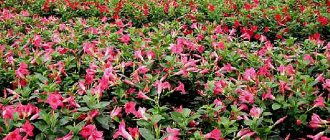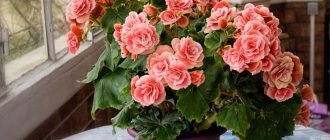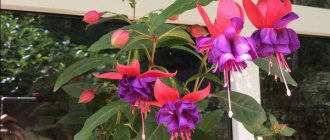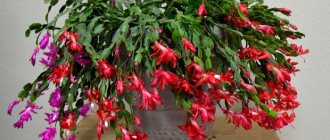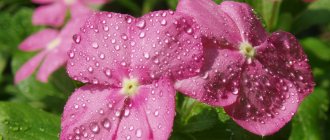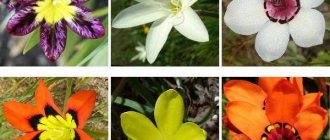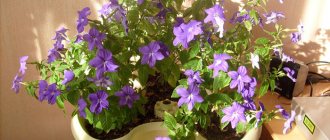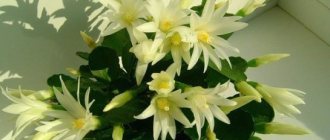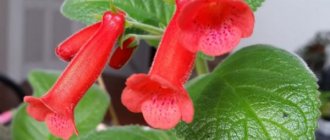Dipladenia, or Mandevilla, is a genus of vines of the Kutrovaceae family. The plant is native to the American tropics. Flowers were brought to Europe by the British, who worked in Bolivia and drew attention to the unusual, beautifully flowering vines. The plant can also be found under the names Chilean Jasmine, Brazilian Jasmine, Brazilian Impatiens, Bolivian Rose, Mexican Tree of Love. Flower growers are attracted by the rapid growth and long flowering of Dipladenia.
Caring for dipladenia at home involves 2 modes: the growing season and stagnation, which differ significantly from each other. If you follow all the rules and recommendations for growing a flower, there will be no hassle with it.
Mandevilla-dipladenia - the queen of indoor vines
Diplademia is also known as mandevilla. This happened because they were simultaneously and independently discovered by two different scientists. At first it was believed that these were two different plants, then the confusion was sorted out and they were combined into one genus, but this plant still has two names.
Dipladenia at home
This ornamental plant belongs to the Kutrov family. Central and South America are considered its homeland. More than 40 species of mandevilla are known. Depending on the growing conditions, Dipladenia can grow into a flowering bush or become a decorative branching vine.
The stems of the flowering vine can grow up to 4 m. The leaves are dense, shiny and slightly elongated, they have a dark green color. Flowers can have different colors from white to red. They consist of five large petals arranged in a cone shape.
Up to fifty flowers can grow on one vine. The size of each of them is 5-12 cm. After the flower blooms, it lives for at least 14 days. Some varieties of Dipladenia have a pleasant aroma.
It must be remembered that this plant, although very beautiful, is nevertheless poisonous. Its juice is dangerous. Therefore, it should not be kept in homes with pets or small children.
Dipladenia loose
Used as an indoor or garden flower. Flowers create a pleasant aroma. The length of the stems reaches 4 m. The leaves are greenish-grayish in color and are up to 15 cm long. The size of the flowers is 5 cm. They are white or cream in color.
Note! This variety is characterized by good frost resistance. When grown in the garden in cold weather, it sheds its leaves. When used at home during the dormant period, this vine turns green.
Dipladenia Boliviana
This vine with a thin pink stem and small leaves (up to 4 cm long) is distinguished by beautiful pink flowers. They grow in the form of inflorescences of 5-8 pieces.
Popular varieties
There are several varieties that are most suitable for growing at home, and therefore are in high demand.
- Dipladenia loose or Chilean jasmine is a South American liana, which is distinguished by its rapid growth, the presence of flexible and thin shoots, and matte rich leaves. The flowers are star-shaped and open from mid to late summer. The petals have corrugated edges and reach 5 cm. The variety is fragrant and noble in appearance.
- Sandera is distinguished by sparsely spaced leaves on smooth shoots. The leaves are dense, reach 5 cm, and the flowers glow in the sun due to translucency and are shaped like stars. Reach 7 cm in diameter. A distinctive feature is a large, yellow throat, regardless of the color of the flowers.
- Splendence has shiny, heart-shaped, elliptical leaves. Clusters of inflorescences are formed from 5-6 flowers, which during flowering can completely cover the plant itself. The outer color is white, and the throat is brighter; the petals have a watercolor transition.
- The Balivian variety is similar in appearance to Sandera, but has exclusively white and small flowers. The leaves are sharper than other species.
- Dipladenia Excellent has reddish shoots and glossy leaves. Bright flowers are collected in brushes of 8 pieces. their length reaches 6 cm.
It is customary to keep the culture in question indoors or in a greenhouse. Open ground is suitable only in subtropical or tropical climates. Dipladenia can be grown at home in the form of an ampelous or climbing crop. The formation of a compact bush up to 45 cm high is possible with timely pruning. The exotic segments contain cardiac glycosides, so all its parts are poisonous; children and animals are prohibited from being allowed into the vine.
Dipladenia: care at home
Dipladenia ampelae or Mandevilla - home care
Mandevilla, Dipladenia is the queen of indoor vines, but only proper care will allow you to see luxurious tropical flowering.
Choosing soil for dipladenia
It is necessary to prepare the soil, which will be loose and can easily pass water and air for the roots of the plant. To ensure this, sand or small red brick chips are mixed into the ground.
The soil must necessarily contain a fertile layer. In this capacity, humus, soil from a greenhouse, or soil in which cucumbers were previously grown can be used. It is permissible to purchase commercial soil for dipladenia.
Luxurious tropical flowers
Watering and fertilizing mode
In its wild habitat, Dipladenia grows in tropical rainforest conditions. Therefore, it is important for it to provide similar conditions where it is going to be grown. To ensure constant air humidity, dipladenia needs to be sprayed regularly. You can also place it in a tray with a small amount of moistened gravel. As it dries, constantly add a little water. This is especially important to do during the period that begins with the opening of the buds and ends with the petals falling off.
Important ! When this vine blooms, it needs watering, which should occur twice a week. As soon as the top 2 cm of soil has dried, it is necessary to add moisture again.
This liana is very demanding on the quality of the water received. For this purpose, you need to use only filtered, boiled and cooled water.
Mandevilla likes the water to have minimal lime content. If you collect water from rain for irrigation, it will suit dipladenia well. However, this will only happen if the water is collected in rural areas.
In winter, the plant also needs watering, but the time for it comes provided that the soil is completely dry after the previous moisture and three more days have passed after that.
In order to provide the air suitable for the plant, you can use a humidifier. It is recommended that the percentage be 70%.
Important ! Under natural conditions, the vine grows in acidic soils. Therefore, it is recommended to add a little lemon juice or vinegar to the water. In the latter case, the smell must dissipate before use.
This plant needs feeding during the spring-autumn period. At this time, it is necessary to fertilize the flower 4 times a month. Any complex flower fertilizer is suitable for dipladenia. It should be taken into account that nitrogen fertilizers promote the growth of foliage and stems, while potassium and phosphorus fertilizers promote the formation of flowers.
Requirements for illumination of the place
This plant prefers good light, but does not tolerate direct sunlight. A good option for Dipladenia would be a shaded place on a sunny day.
It is recommended to choose the eastern side of the apartment to grow a flower. In the warm season, dipladia will feel comfortable on the balcony.
Flowers on the balcony
Description
Mandevilla is an evergreen climbing or climbing vine that grows quickly. Indoor dipladenia is a flower that is slightly different from its wild representatives: its appearance is more decorative and attractive.
Mandevilla has a woody stem that is quite strong and durable. The shoots grow up to 200 cm. The leaves are opposite, oval-shaped, dense. The surface of the sheet is glossy and smooth. Color – rich bright green. Inside the leaf there is a poisonous, whitish milky sap.
The flowers are large, can reach up to 12 cm in diameter. The color is white, pink, crimson, red or dark pink, depending on the species. May have a pronounced aroma. Blooms profusely.
Dipladenia: growing and care in the garden
If a florist has started this plant, he must remember that care for dipladenia must be thorough and timely.
Mandevilla flower - home care
In October and November, it is customary to prune the plant. In this case, you need to carefully examine the plant and remove all old branches. Flowers in the garden grow actively only on young shoots.
Important ! You need to pay attention to old shoots that have not branched. They need to be shortened by 2/3 of the original length. Those that have already branched need to be pruned after the fork. In this case, cut off half or a third of the remaining branches.
Growing and caring for dipladenia at home suggests that pruning is important not only to ensure the growth of the plant, but also to form a beautiful bush.
It must be remembered that the juice of this plant is poisonous. Therefore, all work with it must be done with gloves.
It is necessary to grow a vine using a support. It is recommended that its height be one and a half times greater than an adult plant.
Dipladenia care
To achieve abundant flowering and to increase the plant’s immunity, it is necessary to provide proper care for dipladenia. Regularly prune old shoots, otherwise the decorative properties of the vine will be lost. When working with dipladenia, use gloves, since its juice is poisonous; children should not be allowed to care for the flower. A brighter color can be achieved by providing conditions with temperatures above 25 degrees during the day. For irrigation, use water acidified with vinegar, which must first be kept in an open container for 3 days so that the smell disappears.
Lighting Choose southeast or east windows to place the plant. The northwestern sector will be appropriate in spring and winter. In summer, do not forget to shade the crop to prevent sunburn. In winter, you don’t need to organize additional lighting if the room is warm.
Thermal regime The crop in question does not tolerate heat well, despite the fact that it is tropical. In summer the temperature should be 20-25 degrees. In winter, the contents should be cooler - 12-13 degrees, so that flower buds are formed in a timely manner and flowering begins in late spring.
Air humidity The optimal development of this evergreen plant depends on the air humidity, which should be 50-55%. If the room temperature exceeds 22 degrees, spraying the leaves on a regular basis is mandatory. Be careful not to let moisture get on the flowers. For spraying, use settled water at room temperature. This procedure can be avoided if the culture is kept in slightly cool conditions.
How to water? This exotic requires abundant watering, make sure that the soil does not dry out, but is not too wet. Use water that is not too hard and at room temperature. The leaves of the vine can curl if the air is too dry, so it is forbidden to place dipladenia near heating devices. Periodically wipe the foliage so that air exchange is at an optimal level, so the plant will not lose its decorative appearance and shine.
During the period from mid to late winter, provide the vine with rest at a temperature of 12-15 degrees, watering should be rare. This measure will ensure the normal formation of flower buds. With the beginning of the growing season in March, Dipladenia will begin to produce new shoots. During this period, it is necessary to take care of increased humidity and air temperature; strictly avoid overcooling the shoots, otherwise flowering will not be abundant. Throughout the entire period of active development, regularly fertilize every 2 weeks. Complex mineral fertilizers diluted in water are suitable. They can be combined with water for irrigation. It is necessary to stop feeding at the end of summer.
Transplantation The exotic plant in question needs an annual replantation, which must be carried out in early spring. There are two options for the composition of the soil mixture.
- Two parts clay-turf mixture to one part sand, part leaf soil and part humus.
- Three parts sheet soil to two parts peat, one part humus and part sand.
The addition of vermiculite and clay is welcome if you are working with mature specimens that have already formed. The drainage should consist of expanded clay or clay shards so that too much moisture does not accumulate at the root part.
Pruning Dipladenia To prevent your vine from growing to indecent sizes, and the room from turning into a tropical garden, prune Dipladenia. This procedure allows new shoots to form more actively, the plant becomes healthier and more beautiful.
- Select 3-5 main stems after planting, they should be the strongest and youngest.
- Trim the center stem by 2/3.
- Remove unbranched, too long and weak stems by 2/3 in early spring or autumn.
- Branched stems should also be cut by 2/3 after the fork.
- If you are happy with long stems, install supports for them. For this purpose, you can use stretched wire or gratings.
Please note that pruning dipladenia is only relevant for adult specimens. When working with young plants, limit yourself to pinching the top.
Planting in flowerpots
Freesia growing and care at home and in the garden
This hanging plant will look beautiful if grown in a hanging pot. It must be replanted at least once every two years.
If in the spring you notice that roots are coming through the drainage holes, then it’s time to move the flower to a new pot. If the roots do not stick out, then replanting this year is not necessary.
For planting, you need to prepare a suitable soil mixture. It should consist of humus, leaf soil, sand, peat and turf. The best time to plant Dipladenia is spring.
Dipladenia in landscape design
Substrate composition, transplantation
You can prepare the soil mixture yourself and for this you need to mix:
- 1 share of sand;
- 1 share of humus;
- share of leaf soil;
- and 2 shares of clay-turf soil.
If the plant is young, then it is best to replant it in March; an adult dipladenia is replanted only when the roots have occupied the entire pot.
Temperature
During the spring-summer season, the most comfortable temperature for the plant will be 25 °C or higher. In winter, it is recommended to maintain it at 15 °C.
In summer it is important to provide the flower with ventilation. To do this, they take it out onto the balcony or place it next to the house, if possible. It must be remembered that the sun's rays falling on the leaves can cause burns. Therefore, at such times it is important to provide shade for the plant.
If dipladenia grows in an apartment, it needs regular ventilation. In this case, it is necessary to exclude the possibility of drafts.
Heat plays an important role in caring for the Dipladenia flower. The more it is, the juicier and brighter the flowers, the more actively this vine develops.
Since the daylight hours are much shorter in winter, the plant begins to go dormant. At this time, a lower temperature will be required for its comfortable existence. However, care must be taken that the air temperature does not fall below 13 °C.
Guest from South America - dipladenia
Dipladenia, or as it is also called mandevilla, is a decorative deciduous evergreen vine. It is still rarely seen in the collections of Russian amateur flower growers, but in vain. A compact vine with glossy bright green leaves is a real decoration for any interior. Dipladenia blooms almost all summer. Flowers measuring 10–12 cm are beautiful and fragrant.
In natural habitats there are real jungles of Dipladenia
The liana grows in the humid tropics of Brazil, Mexico, Bolivia and other countries in South and Central America.
The flower has two names - dipladenia and mandevilla. The first plants found in the forests of the South American continent were called Dipladenia. Later, other species of Dipladenia were discovered, but they were mistakenly classified as a separate genus, which received the name Mandeville, in honor of Sir Henry Mandeville, an English diplomat and gardener. And both names are still in use.
The liana has two names: Dipladenia and Mandevilla.
Dipladenia is a perennial with shiny, leathery leaves ending in a characteristic pointed tip. The plant has a tuberous rhizome.
Among the people, the liana has received several romantic names: it is called the Mexican tree of love and Bolivian rose, Chilean jasmine and Brazilian balsam.
Brazilian balsam flowers have a variety of colors - from snow-white to cherry-red. Some types of dipladenia have a very delicate aroma and bloom for a long time from May to the end of autumn, with each flower pleasing others with its beauty for about 10–12 days.
Dipladenia can grow exclusively in tropical climates. In our country, it is grown in greenhouse or indoor conditions. The flower is poisonous, all its parts contain dangerous substances, so it is not recommended to grow it where there are small children. When caring for Dipladenia, you must also be careful and wear gloves when carrying out pruning, watering and other procedures.
Why doesn't dipladenia bloom?
When dipladenia grows in the house, cultivation and care must be followed according to all the rules, otherwise flowering will not be achieved.
Although it is possible to plant this plant in open ground, it must be taken into account that it is very vulnerable to low temperatures. When the question arises about why dipladenia does not bloom, one answer may be that the temperature is too low.
How to make Dipladenia bloom at home
It may happen that this plant does not produce flowers at all. In this case, it can be assumed that he lacks the nutrients he receives from feeding. It can be made to bloom if you care for the plant properly.
Sometimes the reason is that the plant needs more light. It is important to avoid direct sunlight.
Why do Dipladenia leaves turn yellow and fall off?
Sometimes you can see that the leaves turn yellow and curl, and then dry out and fall off. The reason for this may be excessive watering. Excessive moisture causes plant disease.
If the vine freezes in winter, this can also cause the leaves to yellow and fall off.
If pests attack, you will need to apply appropriate insecticides.
Note! Sometimes the leaves shed intensively if the basic rules of care are violated. The cause can usually be poor watering, insufficient fertilizing and too dry air.
Disease and pest control
Tender mandevilla is extremely sensitive to cultivation conditions. The slightest blemishes, especially in winter, are fraught with the development of root nematodes, which is manifested by withering of the stems and the formation of galls on the rhizomes. Unfortunately, it is no longer possible to save an infected flower.
All dipladenia diseases occur due to improper care. Regular flower pests are spider mites and mealybugs. At the first signs of their vital activity, you need to treat the stems with insecticides “Aktellik”, “Aktara”, “Agravertin”. Don't forget to inspect the flowerpot regularly
Often, lovers of indoor plants pay attention to the problem when the leaves of the plant have already turned yellow and fallen off or the flower stalks have withered. But in fact, the reason for this behavior lay in the wrong temperature conditions
With a lack of light, the leaves acquire a pale, lifeless color, and the flowerpot practically does not bloom. If the leaves rush down and the young cuttings wither, it is worth increasing the humidity in the room and the soil. Additional feeding will not hurt. Curled, semi-dry foliage indicates dryness in the room and improper placement of the flower.
Perhaps he is under direct ultraviolet rays and is hot. If dipladeniya dries, check to see if there are any pests on it, or if the roots have rotted due to excess moisture. If you are sure that you did not make mistakes in care, and did not detect the activity of harmful insects, the cause of the flower’s discomfort is a poor-quality substrate. The flowerpot needs to be replanted.
Did you know? Ancient tribes lubricated arrows with the poisonous juice of Dipladenia for hunting game. Contemporaries learned to use poison in the treatment of urological and heart diseases.
Dipladenia: reproduction
Dipladenia can be propagated using seeds or cuttings.
To plant seeds, the air temperature must be at least 29 °C. The soil should be loose and slightly acidic. It is moisturized, but not excessively. It is necessary to provide abundant but diffuse lighting.
Seed germination can take up to four months. Growing from seeds is much more labor-intensive compared to using cuttings for this purpose.
Dipladenia flower
Propagation by cuttings
To propagate Dipladenia by cuttings, you need to cut off the shoots of the vine in spring or summer. In the first case, they will still be green, but in the summer they will already become lignified.
Each cutting should have one stem node and 3-5 leaves. To propagate a flower, the branches must be cut at an acute angle and treated with a growth stimulator.
After this, you need to plant them in the ground. The soil mixture for growing should consist of peat, sand and sphagnum.
The cutting is covered with a bag or glass (for example, an inverted jar) and placed in a place where the temperature can be maintained at 25 °C. In this case, the cellophane must be removed for a while in order to ventilate.
After a month or a month and a half has passed, rooting will occur.
Dipladenia is a beautiful ornamental plant. However, it must be provided with suitable care. If everything is done correctly, this plant will delight the gardener with its beauty for many years.
Propagation by cuttings and other options
Dipladenia is propagated by cuttings. When is the best time to start breeding? The best time is early spring. They are cut with one pair of leaves. The cuttings are planted in cups separately and transferred to a warm place. Greenhouse conditions can be replaced by using plastic bags. Cups with cuttings are covered with bags on top. The substrate in this case includes peat, a mixture of peat and sand, or perlite. When small sprouts appear - roots, the polyethylene is removed. Rooting takes approximately 45 days. After two months, the young plants are transplanted into more fertile soil. Before transplanting, moisten the soil. For rapid and efficient emergence of roots, cuttings are deepened to the first pair of leaves. Mandevilla should be kept indoors at plus twenty-five degrees.
Watering is carried out as needed. Usually the cuttings take root well, but occasionally the plant does not form a root system. Then another method of propagation comes to the rescue, but less effective - propagation by seeds. Seeds are sown in spring at 18 - 22 C.
In everyday life you will need:
- Washed and disinfected containers;
- Filling the container with soil: - 1 part deciduous soil plus 50% sand;
- The seeds are sown and sprinkled with sand;
- The earth is slightly moistened and covered;
- Seeds are ventilated every day;
- Sprouts appear after a few weeks;
- When the sprouts reach a height of 7 cm, they are transplanted separately.
There is also the option of propagation by antennae. This method is quite simple, but the effect is not always positive.
To implement it you need:
- Bend the top of the process to the ground plane;
- Fix or attach it in the area of the antennae (the area where it grows);
- Expect rooting.
The rooted shoot is separated and planted in another permanent place.
Variety of species
Mandevilla, Brazilian balsam, Brazilian or Chilean jasmine, Bolivian rose, Mexican love tree are all names that can be used to call dipladenia. Sometimes you can come across the opinion that mandevilla and dipladenia are not the same thing, but this is not the case. The plant received a double name due to the fact that the first varieties studied were called Dipladenia flower, and those found a little later and in another area were called Mandevilla flower. Having compared both of these varieties, botanists realized that they were the same plant. But both names remained for the same flower.
This beautiful evergreen plant has shiny, leathery, dark green foliage shaped like pointed ovals. Succulent leaves are framed by bright funnel-shaped flowers with five petals. They come in various shades in accordance with the species and variety.
The most common types of dipladenia are:
- Dipladenia splendens is an evergreen vine with long, up to four meters, shoots. Often used as an ampel flower. The flowers are a rich bright pink color and reach ten centimeters in diameter.
- Dipladenia sanderi is a vine whose shoots grow up to three meters. The flowers are pink with a yellow interior. The most famous varieties of Sandera are “Rubiniana” and “Dark”.
- Dipladenia superb/dipladenia praestans (in some sources dipladenia eximia) is another vine decorated with pink flowers, and also has red bracts.
Dipladenia lucidum
Dipladenia Sander
Dipladenia superb
The listed species are decorated with pink flowers, but dipladenia also comes in yellow, red and white. In addition to varieties with simple petals, there are also double dipladenias. Dipladenia blooms profusely and for a long time; on well-groomed specimens, up to eighty flowers can bloom at once and do not fade for just over a week. In order for a flower to be healthy and feel good, it needs to be properly cared for.
